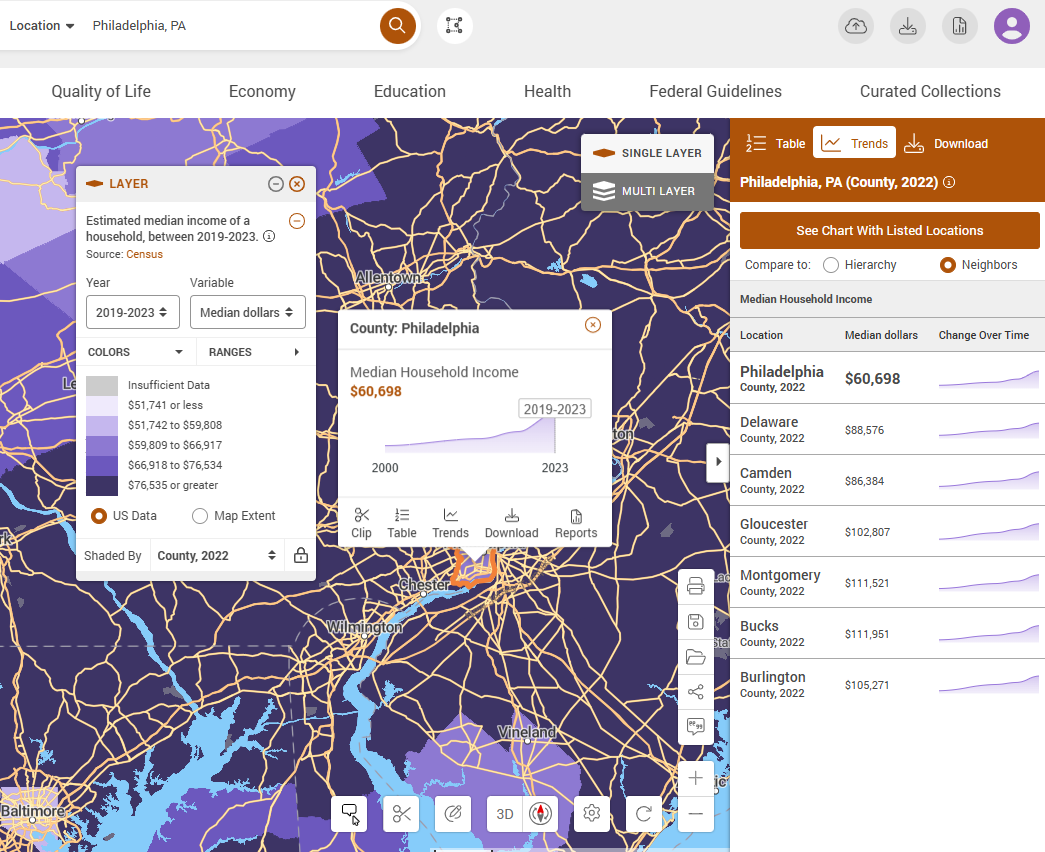ACS Data Updated to 2019-2023

EDITOR’S NOTE: In addition to our annual American Community Survey (ACS) data update, PolicyMap also added 1,078 new indicators from the latest 2019-2023 ACS release in April 2025. Below are a few highlights:
Housing Costs by Race & Ethnicity: Housing costs as a percentage of household income (>30% and >50%) for owners (with/without mortgage) and renters by race and ethnicity.
Homeowners Insurance Costs by Mortgage Status: Yearly homeowners insurance costs for both owners with and without a mortgage.
Ancestry Data for AIAN Populations: American Indian and Alaska Native ancestry is now based on selected tribes and villages (no longer grouped, per tribal consultation feedback).
Expanded Age and Sex Breakdowns: More detailed age data, including breakdowns by sex and a new proxy indicator for females of reproductive age (15–49).
Disability Data: Disability indicators now further disaggregated by age, sex, and veteran status.
Seniors Data: New indicators on poverty status, SNAP participation, and employment status for older adults.
Medicaid and Medicare Data: Expansions on Medicaid enrollment by age groups (under 19, 19–64, and 65+) and by sex, along with Medicare enrollment by sex.
Education Data: New indicators include age and sex disaggregation for educational attainment and school enrollment.
Home Heating Fuel Types: Break out for coal, wood, and solar as separate categories for home heating fuel.
Owner- and Renter-Occupied Housing by Tenure: Expanded indicators include both owner-occupied and renter-occupied units by tenure type.
Homeowner Monthly Costs by Mortgage Status: Details owner‑occupied units’ monthly housing costs by mortgage status.
For more information, contact us.
We’re excited to introduce the latest American Community Survey (ACS) data update, providing a richer, more detailed snapshot of U.S. communities. PolicyMap now features 2019-2023 ACS data, accessible through our interactive maps, charts, reports, and downloads. At PolicyMap, we believe in the power of data democracy—the idea that public data should be accessible to everyone, not just experts or institutions. Our platform simplifies how users explore, visualize, and understand public data, making critical insights available to all.
With over 5,000 updated indicators, this data refresh delivers the latest insights into population characteristics, spanning social, economic, housing, and demographic trends. Additionally, we’ve expanded access to the 2020 Decennial Census, adding nearly 300 new indicators from the Demographic and Housing Characteristics (DHC), offering an in-depth look at population and housing conditions across the country.
Explore the Latest ACS Data 2019-2023 Data on PolicyMap
Accessing and analyzing this data has never been easier. Our platform simplifies the process, allowing users to explore trends in demographics, income, and housing affordability with just a few clicks.
Users can select any Census indicator, enter a location, and instantly visualize demographic trends over the past two decades.

Dive Deeper into Demographics
PolicyMap provides powerful tools to examine demographic trends using key indicators:
- Predominant Racial or Ethnic Group: Identifies the largest racial or ethnic group in an area based on ACS data. If two or more groups have nearly the same percentage, they are marked as tied.
- Diversity Index: Measures the likelihood that two randomly selected people belong to different racial or ethnic groups. A higher score indicates greater diversity.

Compare Local Trends with Regional Benchmarks
PolicyMap’s Trends feature allows users to benchmark local demographic and economic changes against county, state, and national trends—providing critical context on how an area compares to its broader region.
For example, loading median income data for Philadelphia, PA, generates an interactive trend chart revealing income fluctuations and comparison to neighboring counties over time.

Navigating Historical Data with Boundary Updates
Tracking trends over time can be tricky, especially when geographic boundaries shift, or new areas are incorporated. To maintain data continuity, PolicyMap ensures accurate comparisons by bridging boundary changes. When geographic updates impact trend charts, we make adjustments to keep insights clear—meaning trend charts won’t appear if the changes could lead to misleading interpretations. This helps users confidently analyze shifts over time.

What’s New in This Update?
- 2023 Metro Division Boundaries – Reflecting the latest adjustments for more precise regional insights.
- 2023 Metro Area Boundaries – Keeping data aligned with current metropolitan classifications.
Nationwide Data Access & Upcoming Updates
The ACS is one of the most comprehensive datasets available, covering thousands of topics shaping American society. From economic trends to housing conditions, this wealth of data empowers policymakers, researchers, and everyday users to make informed decisions that drive meaningful change. PolicyMap enables users to create maps, visualize trends, generate Community Profiles, and download ACS and Census data for any U.S. neighborhood, city, county, or region.
In the coming weeks, PolicyMap will add more new ACS indicators, providing users with even deeper insights into the social, economic, and demographic fabric of communities. Stay tuned as PolicyMap continues to enhance its platform with powerful data and features–sign up for our newsletter, or follow us on LinkedIn, BlueSky, Facebook, or X (formerly Twitter).
Request More Information
From understanding changing population dynamics to pinpointing socioeconomic shifts, the ACS update provides a wealth of information crucial for making data-driven decisions. Ready to learn more about the data in PolicyMap? Request a demo and data walk-through by completing the form below.